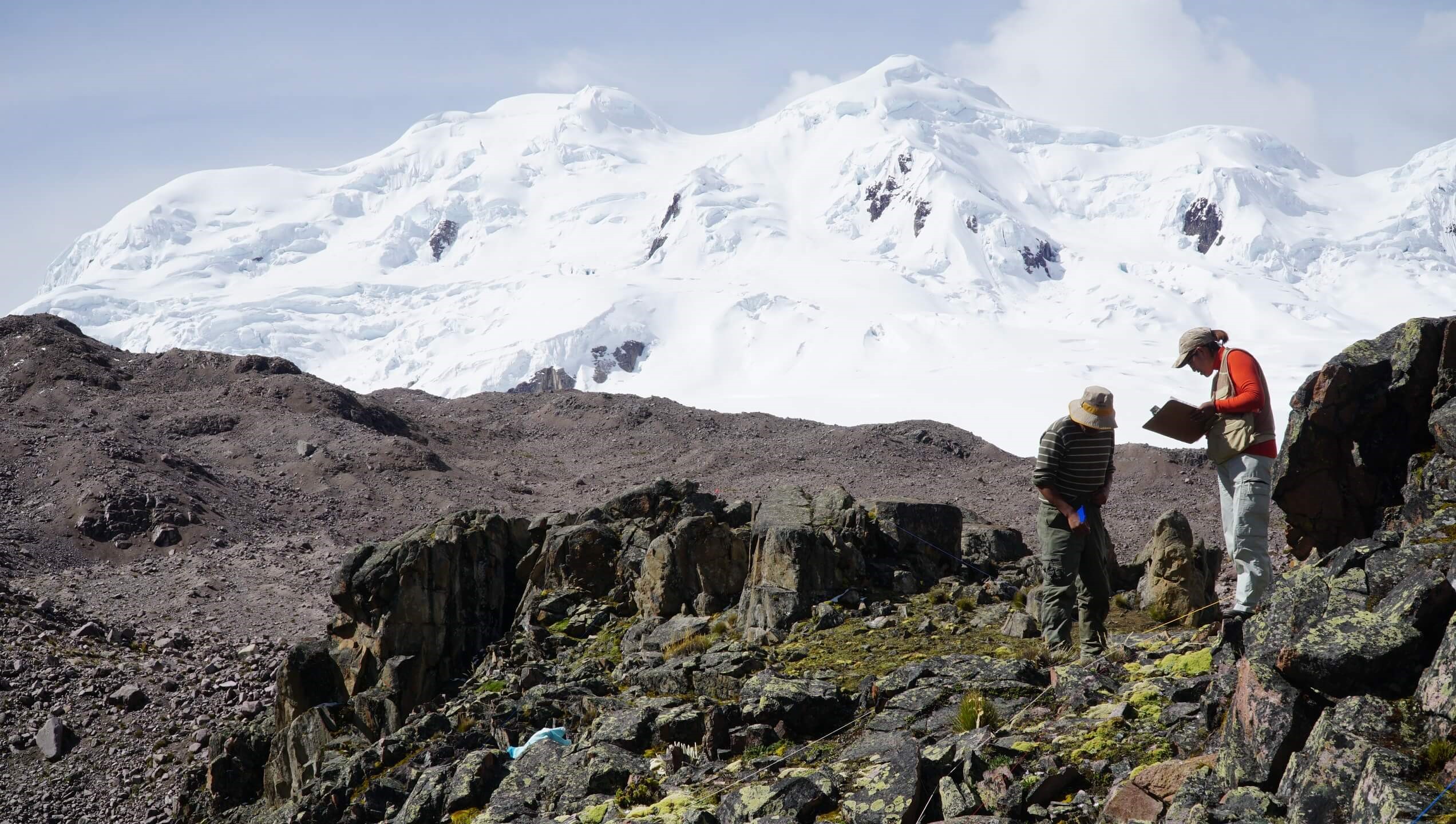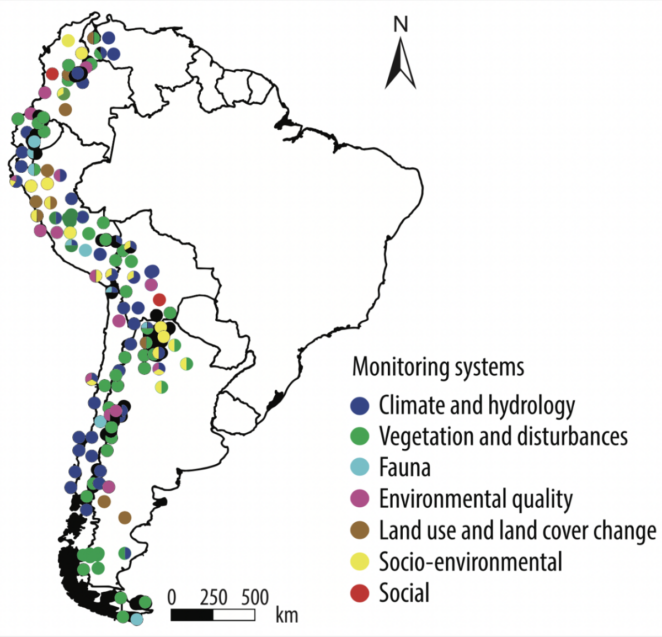Long-Term Social-Ecological Monitoring in the Andes: How are we doing?

Long-Term Monitoring Systems in the Andes
Monitoring the state of social-ecological systems (SES) in the Andes, a mountain range spanning an entire continent, is a challenging task. Assessing the state of a wide range of ecosystems and social realities, from the tropics to southernmost tip of South America, requires coordination between a large number of research institutions and stakeholders in the seven Andean countries. The planning of environmental and adaptation policies has to be informed by integrated, systematic and standardized knowledge from long-term social–ecological monitoring (LTSEM) systems. So, how is it going? Where is LTSEM done in the Andes, what kind of knowledge is generated, what needs to be improved?
These are the central questions addressed by a group of researchers from Argentina, Ecuador, Peru and Venezuela, in a recent paper published in “Mountain Research and Development”. The study, Long-Term Environmental and Social Monitoring in the Andes: State of the Art, Knowledge Gaps, and Priorities for an Integrated Agenda, aims to identify the state of the art, knowledge gaps, and monitoring priorities for a research agenda targeted toward Andean LTSEM.
This article is based on the original text “Long-Term Environmental and Social Monitoring in the Andes: State of the Art, Knowledge Gaps, and Priorities for an Integrated Agenda” published in Mountain Research and Development, 43(2), under the CC BY 4.0 license in March 2023 © Carilla et al. Please note that references have been removed.For more detail, full references, and to quote text please use the paper available for download on the right.
Methods
The research team compiled a database of all monitoring sites, classified according to the issues addressed: climate and hydrology, environmental quality, fauna, vegetation and disturbances, land-use and land-cover change, social–environmental, and social analyses. A survey of Andean LTSEM systems was carried out through an open questionnaire implemented in Google Forms, distributed to 425 experts and decision-makers known to be involved in research, monitoring, or policy design in the Andes. A distribution map of all monitoring projects that have more than one study site, and that are maintained over time, was prepared using the results of this survey, together with the author’s own research experience, expert opinion, and a review of the literature (Fig. 1).

The information collected on existing platforms, networks, observatory programs and monitoring projects in the region was systematized and analyzed. Quantitative methods combined with expert knowledge were used to build a conceptual model for the operation and monitoring of the Andean SES. Two virtual interdisciplinary meetings were held to collect the opinions of experts and knowledge demands of key Andean stakeholders. 53 actors from all the Andean countries were invited to a discussion panel, where scientists and decision-makers shared monitoring experiences, and identified challenges to integrating Andean LTSEM systems.
The conceptual model was contrasted with existing monitoring efforts compiled and classified according to their issues. An immersive session was organized, gathering researchers from natural and social sciences and decision-makers from public and private sectors from all Andean countries. Participants combined the tools provided by the conceptual model with their experience and knowledge, identifying the main constraints in the implementation of efficient LTSEMs and their integration in decision processes.
The model is a tool to graphically represent the articulation and information flow between different stakeholders in the Andean SES, and their relationships to a global context of climate change. Four types of elements were identified: the SES themselves, the actors (academia, government, community), the processes involved, and the interactions between all factors. This methodology helped identify a number of research priorities, and recommend actions to promote each of them.
Conclusions and recommendations
The main conclusion of the analysis is that social aspects are underrepresented in existing socio-environmental monitoring programs in the Andes: the vast majority of monitoring systems have an environmental, biological or biophysical focus. This tendency to sub represent social aspects in monitoring has already been identified in other studies (see for example Llambí and Garcés, CONDESAN 2021), and in this work its true dimension is quantified: of 239 records of long-term monitoring systems term in the Andes, only 77 incorporate some type of social approach, and only 4 are from the social sciences. Social participation in projects is very low.
The authors advocate for a reconceptualization of Andean SES monitoring approach, emphasizing the social aspect, and integrating all stakeholders. Research priorities for Andean LTSEM were classified into five categories:
(1) System conceptualization: an effort of characterization of the main elements in Andean SES is required, with a classification based on unified indicators and conceptual approaches. The development of integrated models of Andean SES to frame a transdisciplinary approach in long-term studies is recommended.
(2) System functioning: an integration of systematic social–ecological information is necessary, through unified protocols and coordination between individual monitoring systems. This can inform forecasts of the functioning of Andean SES under environmental change scenarios
(3) External dynamics: the effect of other global drivers of change, such as international trade, must be monitored.
(4) Governance: a more socially relevant governance of Andean SES requires effective evaluation of the results of policies, and a wider implementation of participatory research. Different LTSEM systems should be coordinated, with a key role played by long-term integrated learning sites, and facilitation of the dialogue between technical and community-based knowledge systems. Promotion of science–policy dialogue is a key point.
(5) Information accessibility: integrated social-ecological indicator platforms are increasingly contributing to the availability of data. Regional system analysis, a key tool to improve the adaptive management of Andean SES, requires information that is coherently gathered and accessible.
Among the challenges identified: the need to involve the integration of different disciplines and spatio-temporal scales, and to use unified indicators that serve as support for decision-making at the regional level. In the effort to reinforce the social dimension of long-term monitoring systems in the Andes, research networks and long-term learning sites will play a key role, as generators of integrated information and analytical synthesis to inform science-based policies.
Suggested Citation:
Carilla et al. (2023), “Long-Term Environmental and Social Monitoring in the Andes: State of the Art, Knowledge Gaps, and Priorities for an Integrated Agenda”, Mountain Research and Development, Vol 43, No 2.https://doi.org/10.1659/mrd.2022.00018
Related resources
- Building strongholds for people and nature in the high Andes
- Mountain observations: Monitoring, data, and information for science, policy, and society
- The Andes Monitoring Networks strengthen their skills in the course "Analysis of vegetation dynamics data in the Andes"
- Current state of climate change policies and adaptation strategies in the Andes: A multi-sectoral view from the mountains
(0) Comments
There is no content